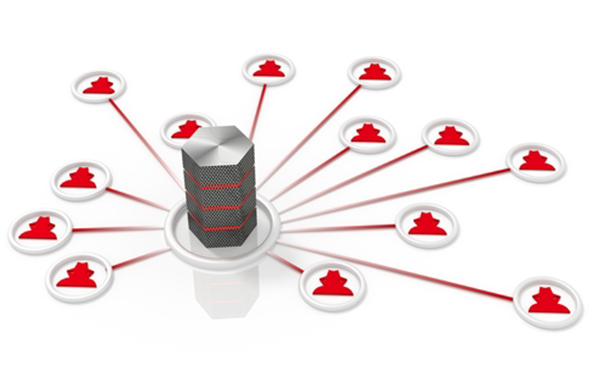DDoS Definition
How Does DDoS Work – A Distributed Denial of Service (DDoS) attack takes place when an attacking computer blocks or disrupts the ability of elements inside your server to communicate. It could prevent your server from connecting to the Internet, or it may lock you out from connecting to the data server or the blades within it.
How does a DDoS work?
In communication, one user sends a message to a server for authentication, and the server then responds with authentication approval. The exchange starts when this authentication approval is acknowledged by the user. In the case of a DDoS attack, the user intentionally sends numerous authentication requests, thus filling up the server. These requests will have false return addresses, and hence the server will not be able to find the user to send the authentication approval. The server closes the connection after waiting for some time and the process begins again when the attacker sends another batch of fake requests. keeping the website/server blocked to all legitimate needs for as long as this chain continues. Attackers make use of multiple hacked computers and internet connections that are under their control to send messages to the target server or system.

How to defend against a DDoS attack?
There are several approaches you can apply to defend against a DDoS attack. Some of these approaches are emphasized below:
-
Plan for Scale
Two primary considerations for mitigating large-scale volumetric DDoS attacks are bandwidth (or transit) capacity, and server capacity.-
Transit capacity: When architecting your applications, ensure that your hosting provider provides enough redundant Internet connectivity that permits you to handle large volumes of traffic. Since the principal focus of DDoS attacks is to affect the availability of your applications and resources, you should locate them, not just close to your end users but also to giant Internet exchanges which will provide your users easy access to your application during high volumes of traffic. Moreover, web applications can go a step further by using Content Distribution Networks (CDN) and smart Domain Name System (DNS) resolution services which provide an extra layer of network infrastructure for serving content and resolving DNS queries from locations that are mostly closer to your end users.
- Server capacity: Many DDoS attacks are volumetric attacks that use up too many resources; hence it is important for you to quickly scale up or down on your computation resources. Scaling can be done by running on bigger computation resources or those with more extensive network interfaces or improved networking that support huge volumes. It is also common to use load balancers to constantly monitor and shift loads between resources to prevent the overloading of anyone's supply.
-
-
Reduce Attack Surface Area
Minimize the surface area that can be attacked thus limiting the options available for attackers and allowing you to build protections in a single place. -
Install Firewalls for Sophisticated Application Attacks
One good practice that will help prevent a DDoS attack is to install a Web Application Firewall (WAF). The WAF will protect you against attacks like Structured Query Language (SQL) injection or cross-site request forgery that make attempts to exploit a vulnerability in your application. Due to the unique nature of these attacks, you should be able to effortlessly develop customized mitigations against illegal requests that are disguised as good traffic and requests coming from bad IPs or unexpected geographies.
Comodo cWatch as a DDoS Attack Prevention Tool
Comodo cWatch Web is the only solution on the market to combine a complete security stack managed by human expertise in a single solution. This web security tool is a Managed Security Service for web applications and websites that combines a Web Application Firewall (WAF) provisioned over a Secure Content Delivery Network (CDN). It is a fully managed solution from a Cyber Security Operation Center (CSOC) staffed with certified security analysts who are available 24/7 and is powered by a Security Information and Event Management (SIEM) capable of leveraging data from more than 85 million endpoints to detect and mitigate threats even before they occur.
cWatch Web also provides malware detection scanning, preventive methods, and removal services to enable organizations to adopt a proactive approach that will help protect their business and brand reputation from infections and attacks. The vulnerability scanning feature provides businesses, online merchants and several other service providers handling credit cards online with an automated and simple way to stay compliant with the Payment Card Industry Data Security Standard (PCI DSS).
As a reliable DDoS attack prevention tool, cWatch is a WAF that functions as a powerful, real-time, cutting-edge protection for web applications and websites by providing advanced security, filtering, and intrusion protection. The Comodo WAF removes application vulnerabilities and protects web applications and websites against advanced attacks such as SQL Injection, DDoS, and Cross-Site Scripting. Available with malware scanning, vulnerability scanning, and automatic virtual patching and hardening engines, the Comodo WAF succeeds in providing robust security that is wholly managed for customers as part of the Comodo cWatch Web solution.





